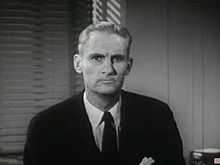Hanson W. Baldwin

Hanson Weightman Baldwin (March 22, 1903 - November 13, 1991) was the long-time military editor of the New York Times. He won a Pulitzer Prize "for his coverage of the early days of World War II". He authored or edited numerous books on military topics.[1]
Early life
Hanson Baldwin was the son of Oliver Perry and Caroline (Sutton) Baldwin. He was born in Baltimore, Maryland on March 22, 1903.
He attended the Boys' Latin School of Maryland in Baltimore and graduated from the United States Naval Academy in 1924. After three years of naval service he began his newspaper career in 1927 as a reporter for The Baltimore Sun. He joined the New York Times in 1929 and wrote for them for the next forty years. In 1937 he became the paper's military analyst. That year, he spent four months in Europe reporting on the military preparedness for what was viewed as the coming war. One of his first major stories in 1938 was of the interception of the ocean liner Rex by U.S. B-17 Flying Fortresses, in which he personally participated.
Career
During World War II he wrote from the South Pacific, North Africa and Europe.[2] His dispatches from Guadalcanal and the Western Pacific won him the Pulitzer Prize in 1943. In 1959 he broke the news of high-altitude atomic bomb test by the United States, known as Project Argus. Besides working for The Times, he lectured and wrote regularly for magazines, scholarly quarterlies and for professional military publications. His papers were given as "The Hanson W. Baldwin Collection" to the George C. Marshall Research Foundation.[3] After his retirement he continued to write articles on military affairs for the news columns and Op-Ed page of the New York Times.
He authored scores of books on military and defense topics. His books published are: Men and Ships of Steel (1935), We Saw It Happen (1938), The Caissons Roll (1938), Admiral Dealth (1939), What the Citizen Should Know About the Navy (1941), United We Stand (1941), Strategy for Victory (1942), The Navy at War (1943), The Price of Power (1947), Great Mistakes of the War (1949), Sea fights and Shipwrecks (1955), The Great Arms Race (1958), World War I: An Outline History (1962), The New Navy (1964), Battles Lost and Won: Great Campaigns of World War II (1966), Strategy for Tomorrow (1970), The Crucial Years, 1939-1941 (1976), and Tiger Jack (1979).
Besides the Pulitzer Prize, he received many awards and prizes, including the Distinguished Service Medal from Syracuse University in 1944. He also received honorary degrees from Drake University and the Clarkson Institute of Technology.
Personal life
In 1931 he married Helen Bruce Baldwin (1907–1994) of Urbana, Ohio.[4] She wrote poetry and articles on culinary subjects for various magazines. They had two children; Barbara Potter and Elizabeth Crabtree. The Baldwins lived in Chappaqua, New York. In 1947, Rabbi Michael Dov Weissmandl bought the Brewster estate in nearby Mount Kisco and moved the Nitra Yeshiva there to create a self-sustaining agricultural community known as the "Yeshiva Farm Settlement". At first this settlement wasn't welcomed by its neighbors, but in a town hall meeting, Mrs. Baldwin, impressed by Rabbi Weissmandl, defended its establishment and wrote a letter-to-the-editor to the New York Times regarding it. She eventually was instrumental in even getting its neighbors to donate to the Yeshiva. In this settlement which is now called the Nitra Community, she is fondly remembered for her valor and kindheartedness.
Baldwin died in Roxbury, Connecticut on November 13, 1991.
References
Further reading
- Robert B. Davies. Baldwin of the Times: Hanson W. Baldwin, a Military Journalist's Life, 1903-1991 (Naval Institute Press; 2012) 399 pages
External links
|